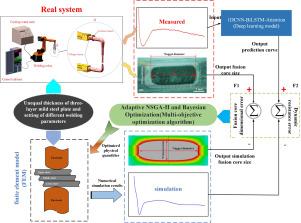基于深度学习和多目标优化的三层不等厚钢电阻点焊实验
IF 5.4
2区 工程技术
Q2 ENGINEERING, MANUFACTURING
CIRP Journal of Manufacturing Science and Technology
Pub Date : 2025-08-05
DOI:10.1016/j.cirpj.2025.07.005
引用次数: 0
摘要
三层不等厚度钢板的电阻点焊在准确模拟焊核形成和过程信号行为方面存在很大挑战。本文提出了一种结合深度学习和多目标优化的混合方法来提高仿真精度。结合一维卷积神经网络(1DCNN)、双向长短期记忆(BiLSTM)和注意机制,从工艺参数预测动态电阻曲线。然后将这些预测曲线用作ANSGA-II和贝叶斯优化框架中的基准,以校准有限元模型中的热电接触参数。实验结果表明,优化后的模拟与实测数据吻合较好,平均绝对误差(MAE)为0.132,均方根误差(RMSE)为0.156,R2值为0.91。校正后的模型将电阻预测误差降低了30%以上,并提高了多种厚度配置下的熔核直径和焊缝深度预测精度。该集成框架为在复杂的多层焊接场景中增强RSW仿真提供了实用且数据高效的解决方案。本文章由计算机程序翻译,如有差异,请以英文原文为准。

Experiments on resistance spot welding of three layers of unequal thickness steel based on deep learning and multi-objective optimization
Resistance spot welding (RSW) of three-layer steel sheets with unequal thicknesses presents significant challenges in accurately simulating weld nugget formation and process signal behavior. This paper proposes a hybrid approach that combines deep learning and multi-objective optimization to improve simulation accuracy. A 1D convolutional neural network (1DCNN), bidirectional long short-term memory (BiLSTM), and attention mechanism are integrated to predict dynamic resistance curves from process parameters. These predicted curves are then used as benchmarks in an ANSGA-II and Bayesian optimization framework to calibrate thermal-electrical contact parameters in a finite element model. Experimental results demonstrate that the optimized simulations closely match measured data, achieving a mean absolute error (MAE) of 0.132, a root mean square error (RMSE) of 0.156, and an value of 0.91. The calibrated model reduces resistance prediction error by over 30% and improves nugget diameter and weld depth prediction accuracy across multiple thickness configurations. This integrated framework offers a practical and data-efficient solution for enhancing RSW simulations in complex multi-layer welding scenarios.
求助全文
通过发布文献求助,成功后即可免费获取论文全文。
去求助
来源期刊

CIRP Journal of Manufacturing Science and Technology
Engineering-Industrial and Manufacturing Engineering
CiteScore
9.10
自引率
6.20%
发文量
166
审稿时长
63 days
期刊介绍:
The CIRP Journal of Manufacturing Science and Technology (CIRP-JMST) publishes fundamental papers on manufacturing processes, production equipment and automation, product design, manufacturing systems and production organisations up to the level of the production networks, including all the related technical, human and economic factors. Preference is given to contributions describing research results whose feasibility has been demonstrated either in a laboratory or in the industrial praxis. Case studies and review papers on specific issues in manufacturing science and technology are equally encouraged.
 求助内容:
求助内容: 应助结果提醒方式:
应助结果提醒方式:


